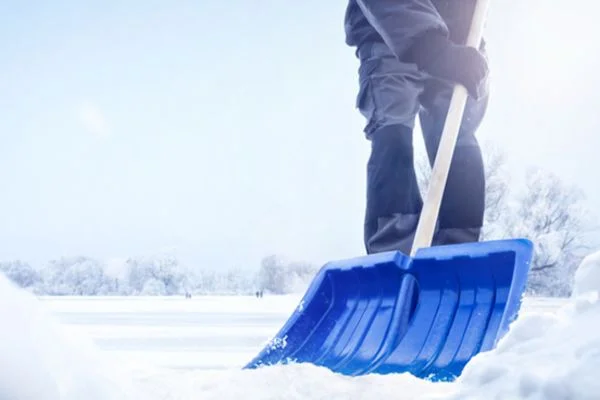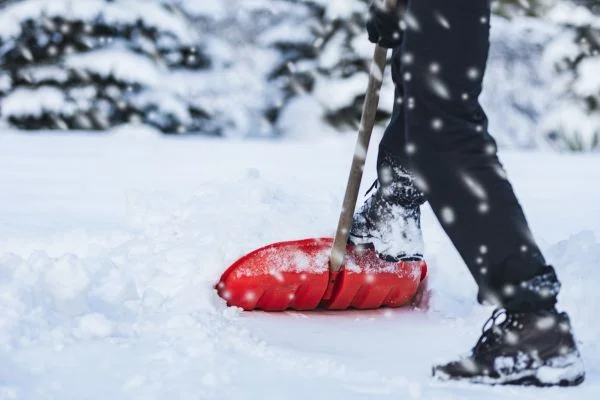After a snowfall, nothing is more frustrating than discovering that the snow has frozen solid overnight. Trying to shovel frozen snow can be difficult and dangerous, as the cold temperatures can cause muscle strains and slips. But you can do the job safely with the right tools and techniques. Let’s look at how to shovel frozen snow like an expert.
To shovel frozen snow effectively, start early, use a sturdy shovel, lift with your legs, and work in small sections. Apply ice melt for safety and ease.
How To Shovel Frozen Snow | Pro Guide
Tools of the Trade
The most important tool for shoveling frozen snow is—you guessed it—a shovel! Make sure you have an appropriate size shovel for your needs; if you’re dealing with a large area or deep snow, you may want to invest in a larger shovel.
Having some deicer on hand, rock salt or calcium chloride, will do the trick and help make your job easier. Finally, dress appropriately for the cold weather by wearing gloves, boots, and layers of clothing that will keep you warm but not restrict your movement.
Breaking it Up
Before attempting to scoop up the frozen snow, you need to break it into smaller chunks with an ice chopper or something like a metal garden hoe.
If any large chunks of ice are in your way, use your deicer liberally until they are broken down into smaller pieces that can be easily moved around. Once everything is broken into smaller pieces, move on to step three.
Also Read: How Does A Folding Shovel Work?
Scraping and Scooping
Now it’s time to start scraping and scooping up all those small pieces of ice! Use your shovel to scrape underneath each piece, then lift it from its original spot. To make this job easier, try using a plastic scoop shovel instead of a traditional metal one; plastic scoops are better suited for lifting light pieces of ice without causing too much strain on your back.
Once all the ice has been raised from its original position, pile it up in another designated area away from its original location. This will help prevent any slipping hazards when walking over the cleared area once finished.
Also Read: Were Folding Entrenching Shovels Used In World War 2?
What Is The Quickest Way To Shovel Snow?

Shoveling snow can be tedious and time-consuming, so it’s important to do it efficiently to get the job done quickly. Here are some tips for shoveling snow quickly:
First, choose the right shovel for the job. Ensure you have a wide enough blade to scoop up large amounts of snow at once and a comfortable handle for your hands and body size. Investing in an ergonomic shovel can save you time and energy as you won’t have to force yourself into awkward positions when shoveling.
Second, wear appropriate clothing while doing the task. Dress warmly so that you don’t get cold while shoveling but make sure not to overdress either; layering will allow you to remove layers if needed when working hard or taking breaks between shovelfuls. Choosing waterproof boots will also help keep your feet dry while out on the drive with all that wet snow!
Thirdly, use proper technique when shoveling – lift with your legs instead of your back! Using stronger leg muscles rather than weaker back ones will protect your muscles from strain.
Start by making one large sweep towards yourself rather than repeatedly lifting small piles of snow; this method should save you time and conserve energy which might otherwise be wasted on multiple trips carrying smaller piles across larger distances until finally reaching where they need depositing.
Also, think about where the cleared-up snows are going – try piling them in an area further away from entrances/driveways etc., against fences or walls where possible etc.
This reduces regular relocations of piled-up chunk & keeps overall productivity higher during each round of clearing up instead of trying reposition snows after every few scoops here & there – something which not only gets tiring but reduces overall effectiveness & productivity rate too!
Finally, take regular breaks throughout shoveling sessions; rest briefly before continuing again as soon as possible since winter weather conditions can take their toll on even determined individuals!
Plus, drinking water regularly helps replenish lost fluids caused by strenuous physical activity – an often overlooked yet critically important factor!
So there we have it – these simple tips should help reduce the time taken to get rid of pesky powdery white stuff from driveways. Hopefully, we no longer dread ‘shoveling Saturdays’ becoming synonymous with colder months!!
Also Read: How To Use Folding Shovel On Camping Trip?
Bottom Line:
How to shovel frozen snow? With these tips in mind, clearing frozen snow should be less intimidating! Remember that taking extra precautions when dealing with cold temperatures is essential for protecting yourself from injury; always wear protective gear such as boots and gloves when tackling this kind of job!
And if things become too overwhelming or dangerous—take a break! Your health should always come first when working outdoors during winter months. Good luck!



